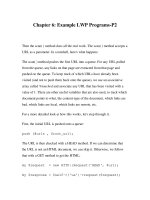Chapter 6 Object-Oriented Design pptx
Bạn đang xem bản rút gọn của tài liệu. Xem và tải ngay bản đầy đủ của tài liệu tại đây (389.94 KB, 65 trang )
Chapter 6
Object-Oriented
Design
© 2004 Pearson Addison-Wesley. All rights reserved 6-2
Object-Oriented Design
•
Now we can extend our discussion of the design of classes and objects
•
Chapter 6 focuses on:
software development activities
determining the classes and objects that are needed for a
program
the relationships that can exist among classes
the static modifier
writing interfaces
the design of enumerated type classes
method design and method overloading
© 2004 Pearson Addison-Wesley. All rights reserved 6-3
Outline
Software Development Activities
Identifying Classes and Objects
Static Variables and Methods
Class Relationships
Interfaces
Enumerated Types Revisited
Method Design
© 2004 Pearson Addison-Wesley. All rights reserved 6-4
Program Development
•
The creation of software involves four basic activities:
establishing the requirements
creating a design
implementing the code
testing the implementation
•
These activities are not strictly linear – they overlap and interact
© 2004 Pearson Addison-Wesley. All rights reserved 6-5
Requirements
•
Software requirements specify the tasks that a program must accomplish
what to do, not how to do it
•
Often an initial set of requirements is provided, but they should be critiqued and expanded
•
It is difficult to establish detailed, unambiguous, and complete requirements
•
Careful attention to the requirements can save significant time and expense in the overall project
© 2004 Pearson Addison-Wesley. All rights reserved 6-6
Design
•
A software design specifies how a program will accomplish its requirements
•
That is, a software design determines:
how the solution can be broken down into manageable
pieces
what each piece will do
•
An object-oriented design determines which classes and objects are needed, and specifies how they will interact
•
Low level design details include how individual methods will accomplish their tasks
© 2004 Pearson Addison-Wesley. All rights reserved 6-7
Implementation
•
Implementation is the process of translating a design into source code
•
Novice programmers often think that writing code is the heart of software development, but actually it should be the least creative step
•
Almost all important decisions are made during requirements and design stages
•
Implementation should focus on coding details, including style guidelines and documentation
© 2004 Pearson Addison-Wesley. All rights reserved 6-8
Testing
•
Testing attempts to ensure that the program will solve the intended problem under all the constraints specified in the requirements
•
A program should be thoroughly tested with the goal of finding errors
•
Debugging is the process of determining the cause of a problem and fixing it
•
We revisit the details of the testing process later in this chapter
© 2004 Pearson Addison-Wesley. All rights reserved 6-9
Outline
Software Development Activities
Identifying Classes and Objects
Static Variables and Methods
Class Relationships
Interfaces
Enumerated Types Revisited
Method Design
Testing
GUI Design and Layout
© 2004 Pearson Addison-Wesley. All rights reserved 6-10
Identifying Classes and Objects
•
The core activity of object-oriented design is determining the classes and objects that will make up the solution
•
The classes may be part of a class library, reused from a previous project, or newly written
•
One way to identify potential classes is to identify the objects discussed in the requirements
•
Objects are generally nouns, and the services that an object provides are generally verbs
© 2004 Pearson Addison-Wesley. All rights reserved 6-11
Identifying Classes and Objects
•
A partial requirements document:
The user must be allowed to specify each product by
its primary characteristics, including its name and
product number. If the bar code does not match the
product, then an error should be generated to the
message window and entered into the error log. The
summary report of all transactions must be structured
as specified in section 7.A.
Of course, not all nouns will correspond to
a class or object in the final solution
© 2004 Pearson Addison-Wesley. All rights reserved 6-12
Identifying Classes and Objects
•
Remember that a class represents a group (classification) of objects with the same behaviors
•
Generally, classes that represent objects should be given names that are singular nouns
•
Examples: Coin, Student, Message
•
A class represents the concept of one such object
•
We are free to instantiate as many of each object as needed
© 2004 Pearson Addison-Wesley. All rights reserved 6-13
Identifying Classes and Objects
•
Sometimes it is challenging to decide whether something should be represented as a class
•
For example, should an employee's address be represented as a set of instance variables or as an Address object
•
The more you examine the problem and its details the more clear these issues become
•
When a class becomes too complex, it often should be decomposed into multiple smaller classes to distribute the responsibilities
© 2004 Pearson Addison-Wesley. All rights reserved 6-14
Identifying Classes and Objects
•
We want to define classes with the proper amount of detail
•
For example, it may be unnecessary to create separate classes for each type of appliance in a house
•
It may be sufficient to define a more general Appliance class with appropriate instance data
•
It all depends on the details of the problem being solved
© 2004 Pearson Addison-Wesley. All rights reserved 6-15
Identifying Classes and Objects
•
Part of identifying the classes we need is the process of assigning responsibilities to each class
•
Every activity that a program must accomplish must be represented by one or more methods in one or more classes
•
We generally use verbs for the names of methods
•
In early stages it is not necessary to determine every method of every class – begin with primary responsibilities and evolve the design
© 2004 Pearson Addison-Wesley. All rights reserved 6-16
Outline
Software Development Activities
Identifying Classes and Objects
Static Variables and Methods
Class Relationships
Interfaces
Enumerated Types Revisited
Method Design
© 2004 Pearson Addison-Wesley. All rights reserved 6-17
Static Class Members
•
Recall that a static method is one that can be invoked through its class name
•
For example, the methods of the Math class are static:
result = Math.sqrt(25)
•
Variables can be static as well
•
Determining if a method or variable should be static is an important design decision
© 2004 Pearson Addison-Wesley. All rights reserved 6-18
The static Modifier
•
We declare static methods and variables using the static modifier
•
It associates the method or variable with the class rather than with an object of that class
•
Static methods are sometimes called class methods and static variables are sometimes called class variables
•
Let's carefully consider the implications of each
© 2004 Pearson Addison-Wesley. All rights reserved 6-19
Static Variables
•
Normally, each object has its own data space, but if a variable is declared as static, only one copy of the variable exists
private static float price;
•
Memory space for a static variable is created when the class is first referenced
•
All objects instantiated from the class share its static variables
•
Changing the value of a static variable in one object changes it for all others
© 2004 Pearson Addison-Wesley. All rights reserved 6-20
Static Methods
class Helper
{
public static int cube (int num)
{
return num * num * num;
}
}
Because it is declared as static, the method
can be invoked as
value = Helper.cube(5);
© 2004 Pearson Addison-Wesley. All rights reserved 6-21
Static Class Members
•
The order of the modifiers can be interchanged, but by convention visibility modifiers come first
•
Recall that the main method is static – it is invoked by the Java interpreter without creating an object
•
Static methods cannot reference instance variables because instance variables don't exist until an object exists
•
However, a static method can reference static variables or local variables
© 2004 Pearson Addison-Wesley. All rights reserved 6-22
Static Class Members
•
Static methods and static variables often work together
•
The following example keeps track of how many Slogan objects have been created using a static variable, and makes that information
available using a static method
•
See SloganCounter.java (page 294)
•
See Slogan.java (page 295)
© 2004 Pearson Addison-Wesley. All rights reserved 6-23
Outline
Software Development Activities
Identifying Classes and Objects
Static Variables and Methods
Class Relationships
Interfaces
Enumerated Types Revisited
Method Design
Testing
GUI Design and Layout
© 2004 Pearson Addison-Wesley. All rights reserved 6-24
Class Relationships
•
Classes in a software system can have various types of relationships to each other
•
Three of the most common relationships:
Dependency: A uses B
Aggregation: A has-a B
Inheritance: A is-a B
•
Let's discuss dependency and aggregation further
•
Inheritance is discussed in detail in Chapter 8
© 2004 Pearson Addison-Wesley. All rights reserved 6-25
Dependency
•
A dependency exists when one class relies on another in some way, usually by invoking the methods of the other
•
We've seen dependencies in many previous examples
•
We don't want numerous or complex dependencies among classes
•
Nor do we want complex classes that don't depend on others
•
A good design strikes the right balance









